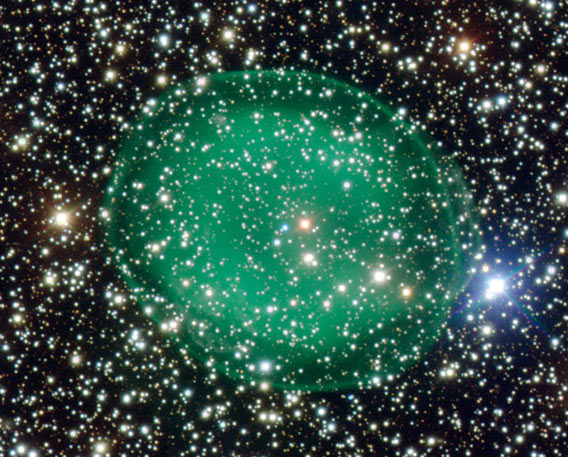Create a free profile to get unlimited access to exclusive videos, sweepstakes, and more!
A Greenly Glowing Football in Space

As long as Iâve been studying and reading about planetary nebulaeâthe expelled gassy shells from dying starsâitâs always a bit surprising that I can find one that a) Iâve never heard of, and 2) has a shape so odd it actually has me scratching my head.
IC 1295 is a green bauble floating in space about 3000 light years from Earth, and in this Very Large Telescope image you can see that itâs a bit weird:
It looks more like something youâd see under a microscope than through a telescope! There are actually quite a few objects with a similar shape to this, but theyâre usually more circular, not so oval. And it has a detached, thin shell, too, which is unusual as wellâespecially since it has the same elliptical shape as the material in side it.
It took me a second, but then I figured the physical shape of the gas must be a prolate ellipsoidâI love me some fancy wordsâwhich means a football shape (more like a rugby ball shape, really). A thin spherical shell of gas in space will look like a thin circle, a soap bubble, through a telescope, but the squashed nature of IC 1295 belies its true physical shape. If itâs elongated, and we see it at an angle, then it will look like a thin ellipse.
Nebulae like this form as a star dies, and starts to blow a wind into space. Over the years it sheds all of its outer layers, exposing the über-hot core, now called a white dwarf. You can see IC 1295âs central star, the sharp blue pinprick just to the left of the brighter, redder star (almost all the stars in this picture are in the foreground or background of the nebula itself).
When the star starts to blow that wind, it can compress the thin gas between stars. Thatâs what forms the thin shell that we see as a detached halo. Over time, the wind from the star speeds up, and slams into the gas expelled earlier. The inner fuzzy glow is from gas heated as that happened. All in all, the outer reaches of the nebula reach about two light years across, which is fairly typical.
I was surprised not to find much in the professional literature about this interesting and pretty object, though it was studied a few years back as part of a survey of similar nebulae. The press release for this image doesnât link to any paper, either, but I hope such a detailed, deep, and frankly gorgeous image gets its due in the scientific process. After all, something like this will happen to the Sun in a few billion years, and learning about this process tells us more about our own eventual fate. Alsoâas is really true astronomically for every object we studyâeach planetary nebula we see is unique, and the more we know about them, the more interesting they become.


























